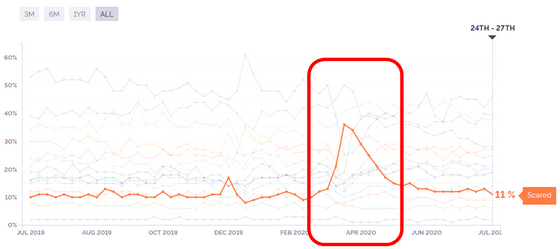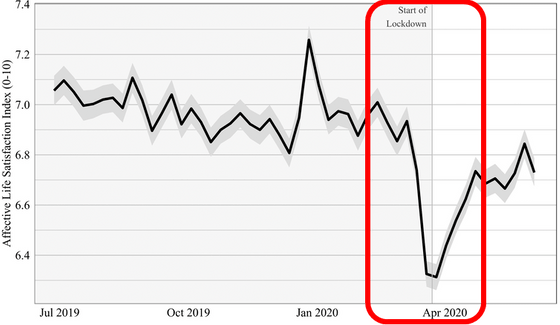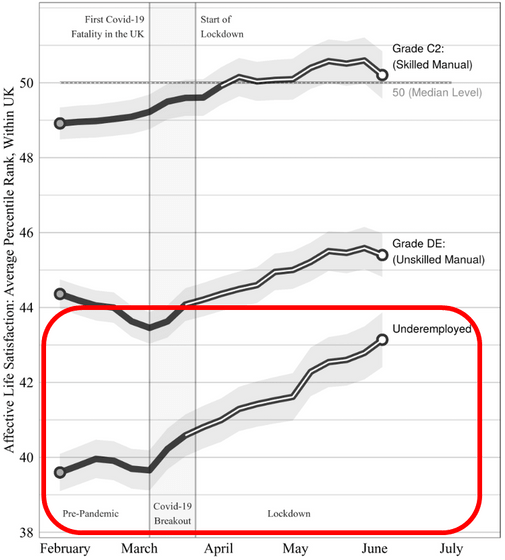Research results that pandemic lowered happiness but recovered by lockdown

During the pandemic of the new coronavirus infection (COVID-19), many people experienced behavioral changes such as refraining from travel and events, quitting work and switching to remote work. While the effects of these pandemics have plunged people's well-being, urban blockages have minimized their negative effects, a study from the University of Cambridge found.
Wellbeing levels fell during the pandemic but improved under lockdown, data analysis shows
Past studies have shown that policies such as lockdown implemented as a countermeasure against COVID-19 protected more than 500 million people worldwide from the threat of COVID-19.
Research results that 530 million people were protected from the new coronavirus due to lockdown etc.- GIGAZINE

While lockdowns have been found to protect the physical health of many, the effects of lockdowns on their mental health have been unclear.
So Mark Fabian, who works at the Bennett Public Policy Research Institute at Cambridge University in the UK, uses the results of a survey on mental condition conducted by market research company YouGov and Google trends, and uses a pandemic and the associated lockdown I investigated the influence that the had on the mental health of people.
Below is a graph of the 'boring' feelings that showed the most characteristic changes in the results of a survey conducted by YouGov on a total of 2000 British people about a total of 12 mental states. From April 2020, when full-scale lockdown started in the UK, it can be seen that the state of chronic boredom continues to be high after the lockdown.

On the other hand, 'fear' jumped sharply at the start of lockdown, but it quickly returned to the level before COVID-19 raged.

In a sense, happiness is in a good contrast to the feeling of 'fear.' “Happiness” fell sharply with the onset of lockdown, but then returned to its original level over the next month or so.

The 'life satisfaction' graph created by Fabian and his colleagues through comprehensive analysis of YouGov data was also very close to 'happiness.'

According to a study that showed that happiness and satisfaction recovered after the start of lockdown, Fabian and his colleagues suggested that 'the satisfaction of life declined with the advent of a pandemic, but that it was recovered by lockdown.' I concluded.
Since the above data were only for the UK, Fabian et al. also conducted a survey that included countries other than the UK. In the survey, negative word usages such as “psychological stress”, “boredness”, “frustration”, “sadness”, “fear” and “apathy” were extracted from Google trend data and summarized by region.
Below is a graph of the negative word search status from February to June 2020 in the United Kingdom (left) and Ireland (right) of the eight countries surveyed. The white part of the bar graph that is color-coded for each period is the period during which 'full lockdown' was implemented, where going out was prohibited in each region. Both graphs show less negative impact at the end of lockdown than at the start of lockdown.

This tendency is seen in the UK (left) and Canada (right)...

Australia (left) and New Zealand (right)

The same was true for countries such as India (left) and South Africa (right).

Fabian and colleagues commented on the result: 'A statistical analysis of Google's data found that the negative impacts fell by an average of 17% one month after the lockdown policy was introduced. It's no wonder that these effects can be seen given that they started at the peak of the number of new infections and deaths of COVID-19.'
It is also known that policies such as income support associated with lockdown also contributed to happiness. The following three line graphs show

``This is likely to reflect the benefits of providing income support to individuals with low SES,'' noted Fabian and his colleagues, who showed significant improvement in satisfaction in groups with low SES. ..
Based on these results, Fabian et al. said, ``In many countries, lockdowns are being unlocked, but if the second wave of COVID-19 arrives, larger lockdowns may be needed. There are many factors involved in deciding whether or not lockdown is necessary, but our research suggests that while there is a negative impact on lockdown, it may reduce the adverse health effects of the pandemic itself. I found out that there are also.'
Related Posts:
in Science, Posted by log1l_ks







